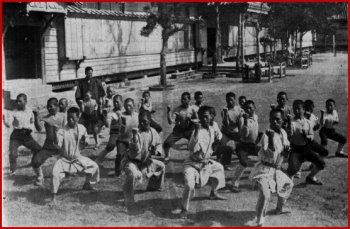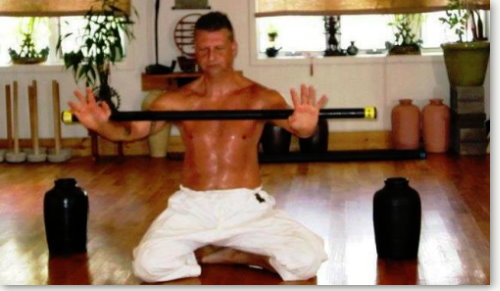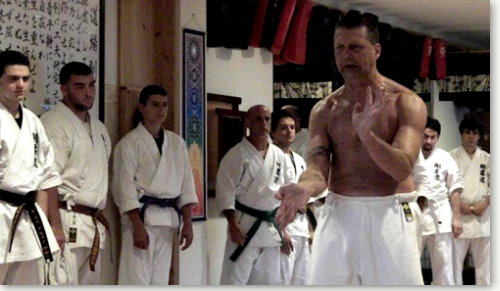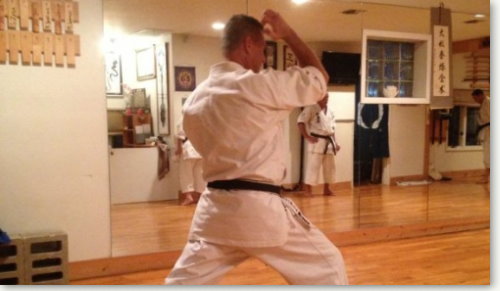Syllabus/Curriculum

The physical practice and theory involves learning and integrating a broad range of fundamental physical skills as well as the underlying physiological and psychological principles upon which the self-protection arts rest. The physical practice and theory of classical Okinawan karate encompasses a core curriculum designed to ensure that the learner achieves the highest level of skill for its intended utilitarian purposes i.e. the simple yet effectively brutal self-defense, while at the same time nurturing the active direction of attention to the philosophical and spiritual aspect of the art.
The Staten Island Kouketsu Dojo syllabus covers a range of techniques encompassing all aspects of punching, kicking, blocking, throwing, grappling, joint-locking and Okinawan Kobudo. Students are also required to demonstrate knowledge of Japanese martial arts terminology, as well as knowledge of the human anatomy.
Kata forms the core teaching syllabus of the Staten Island /Kouketsu Dojo and are listed below.
Sanchin kata 三戦 is the foundation to all other Gojū kata, it is also the foundation of body conditioning. First variation of Sanchin-kata (sanchingata dai-ichi) serves as Kihongata.
Gekisai 撃砕 means "to destroy" or "attack and destroy". This Kata was created by Miyagi Chojun after 1936. The Gekisai kata (Gekisai Ichi and Gekisai Ni) are usually first taught at hachikyū or rokukyū levels (yellow to green belt). Gekisai kata integrates kicking with blocks, strikes, and punches. It introduces the use of tensho technique, how to move in eight directions, side-stepping, back-stepping, and the use of the cat stance
Saifa 砕破 means "to destroy and defeat." This kata is the first traditional Gojū-Ryū's open hand kata. It is usually first taught at gokyu to sankyu levels (green to brown belt).
Seiunchin 制引戦 means "Attack, Conquer, suppress (also referred to as "to control and pull into battle")". This kata is typically taught at sankyu to ikkyu levels (brown belt).
Shisochin 四向戦 means "to destroy in four directions" or "fight in four directions" and emphasizes the power of Goju-ryu, the hard and the soft, and integrates it into one.
Sanseiru 三十六手 means "36 Hands" and is taught at higher black belt levels. The kata teaches complex punching combinations, employs many entry, joint attacks and defenses against kicking attacks.
Sepai 十八手 means "18 Hands". Sepai kata incorporates both the four directional movements and 45° angular attacks and, as in Shisochin, implements techniques for both long distance and close quarter combat.
Kururumfa 久留頓破 means "holding on long and striking suddenly" and its techniques are based on Chinese Praying Mantis style.
Seisan 十三手 means "13 Hands." This kata contains many unusual techniques and demonstrates the difference between Go (Hard) and Ju (Soft). Seisan is thought to be one of the oldest kata quite spread among other Nahate schools.
Suparimpei 壱百零八 means "108 Hands" The most advanced and intricate kata of the Goju Ryu system now. While initially it was known as Pitchurrin and had three levels to master (Go, Chu, and Jo), later Miyagi left only one, the highest, "Jo" level.
Tensho 転掌 is a kata originating from Goju Ryu karate. Translated, it means "revolving hands", "rotating palms", or "turning palms."This kata emphasizes the soft aspects of Goju Ryu, and encompasses continuous, flowing movements. Tensho, along with its harder counterpart sanchin, was developed by Goju ryu founder Chojun Miyagi from earlier Chinese forms. Tensho may be a variant of the Southern Chinese Kung Fu form Rokkishu.
WANT TO FIND OUT MORE?
We're always happy to provide more information on our dojo and classes. For information email: This email address is being protected from spambots. You need JavaScript enabled to view it.


